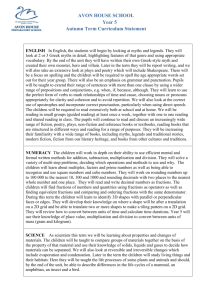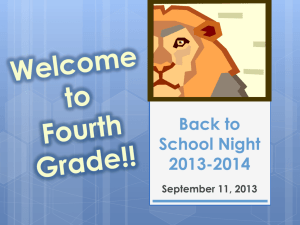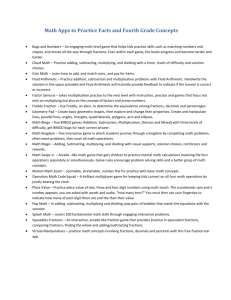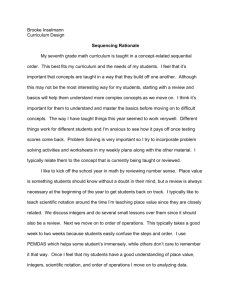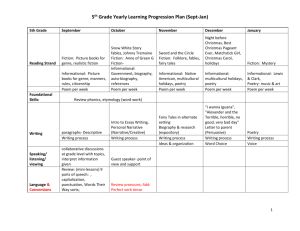Curriculum Overview – Grade 5
advertisement
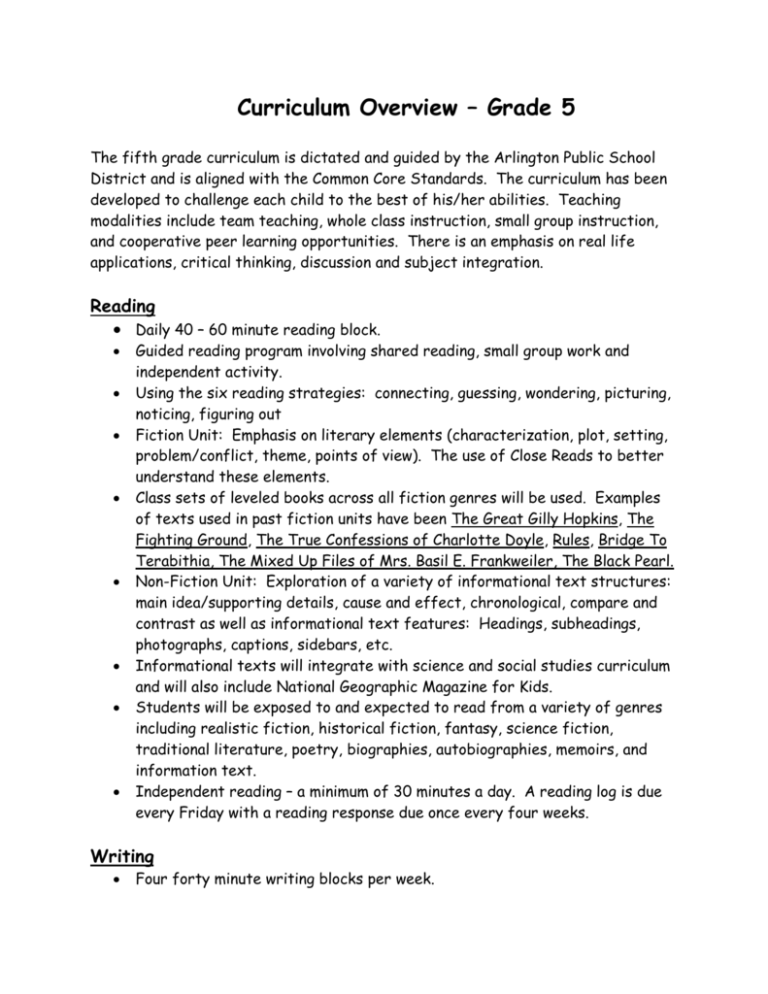
Curriculum Overview – Grade 5 The fifth grade curriculum is dictated and guided by the Arlington Public School District and is aligned with the Common Core Standards. The curriculum has been developed to challenge each child to the best of his/her abilities. Teaching modalities include team teaching, whole class instruction, small group instruction, and cooperative peer learning opportunities. There is an emphasis on real life applications, critical thinking, discussion and subject integration. Reading Daily 40 – 60 minute reading block. Guided reading program involving shared reading, small group work and independent activity. Using the six reading strategies: connecting, guessing, wondering, picturing, noticing, figuring out Fiction Unit: Emphasis on literary elements (characterization, plot, setting, problem/conflict, theme, points of view). The use of Close Reads to better understand these elements. Class sets of leveled books across all fiction genres will be used. Examples of texts used in past fiction units have been The Great Gilly Hopkins, The Fighting Ground, The True Confessions of Charlotte Doyle, Rules, Bridge To Terabithia, The Mixed Up Files of Mrs. Basil E. Frankweiler, The Black Pearl. Non-Fiction Unit: Exploration of a variety of informational text structures: main idea/supporting details, cause and effect, chronological, compare and contrast as well as informational text features: Headings, subheadings, photographs, captions, sidebars, etc. Informational texts will integrate with science and social studies curriculum and will also include National Geographic Magazine for Kids. Students will be exposed to and expected to read from a variety of genres including realistic fiction, historical fiction, fantasy, science fiction, traditional literature, poetry, biographies, autobiographies, memoirs, and information text. Independent reading – a minimum of 30 minutes a day. A reading log is due every Friday with a reading response due once every four weeks. Writing Four forty minute writing blocks per week. Lucy Calkin’s Writer’s Workshop format Five Units of Study: Personal Narrative, Literary Essay, Personal Essay, Memoir, Poetry The six traits of effective writing (Ideas, Organization, Word Choice, Sentence Fluency, Voice, Conventions) will be incorporated into each unit. Students will be encouraged to follow all of the steps in the writing process: Brainstorming, Drafting, Editing/Revising, Final Drafting In addition to writer’s workshop, there will be an emphasis on expository writing (open responses in all subjects). This will include research skills/report writing. Students will have a writer’s notebook in which they will have the opportunity to free write, respond to weekly prompts, or do whatever form of writing that prompts them to write! Students will be encouraged to use word processing to revise, edit, and publish their work. Vocabulary Development from all curricular areas Word of the Week Morning Riddle Mathematics This year we will develop awareness of mathematics by relating it to the real world. We will strengthen mathematical thinking and reasoning, number sense and the use of mathematical language. Students will communicate their mathematical thinking and reasoning both verbally and in writing and will utilize pictures, numbers and words. There are five sixty minute math blocks per week and units of study are as follows: Number Puzzles and Multiple Towers: Students will understand that numbers have relationships and or properties that can help them solve problems. They will reason about numbers and factors and understand the relationship between multiplication and division. An emphasis will be on learning and applying various strategies to solve complex multiplication problems. Thousands of Miles/Thousands of Seats: Students will extend their knowledge of the number system to 100,000 and beyond, review adding and subtracting accurately and efficiently, and understand the place value relationships between 10, 100, 1000 and 10,000. What’s that Portion?: The emphasis of this unit is fractions, fractions and more fractions! A sampling of topics that will be taught are comparing and ordering fractions, adding, subtracting, multiplying and dividing fractions, and finding the decimal and percent equivalents for fractions. Decimals on Grids and Number Lines: Emphasis on reading, writing and comparing decimals. Adding, subtracting, multiplying and dividing decimals will also be taught. Lastly, students will convert measurements within a given measurement system. How Many People, How Many Teams? : Students will work with existing multiplication strategies as well as be taught the standard U.S. algorithm. An emphasis will be on learning and applying various strategies to solve division problems with a two divisor. Measuring Polygon: Finding area and perimeter, classifying triangles and quadrilaterals, describing and measuring angles, creating and describing similar shapes, describing and classifying 2-D shapes, graphing ordered pairs on a coordinate grid Prisms and Pyramids: Emphasis will be on finding the volume of 3-D shapes and taking a closer look at what happens to the dimensions of a prism when the volume is doubled or halved. Patterns, Functions and Change: Students will use graphs and tables to represent change, plot graphs, and describe and represent situations in which the rate of change is constant. How Long Can You Stand on One Foot?: Students will represent, describe, summarize, compare analyze and interpret data. Science A wealth of science topics are covered in fifth grade. There will be an emphasis on the scientific process: inquiry, experimenting, discovery, drawing conclusions, recording through words, charts and illustrations. There are four forty minute science blocks per week. Units of study are as follows: Soil, Erosion, Weathering Plants, Plant Adaptations, Plant Life Cycle Animal Classification, Adaptations, and Life Cycles Climate, Biomes, Ecosystems, Food Chains Matter Forms of Energy (Sound, Light, Electrical, Magnetic, Heat, Chemical) Weather and the Water Cycle Electromagnets The Moon and Solar System Simple Machines Rocks and Minerals Experiments Social Studies Fifth grade social studies focuses on United States History from the first inhabitants to the Age of European Exploration all the way through to the development of our existing government. There is a focus on relating history to life today (similarities, differences, conclusions). There are four forty minute social studies blocks per week and units of study are as follows: People Come to the Americas European Exploration Early English Settlements The Thirteen Original Colonies Road to Revolution – The Revolutionary War Becoming a Nation: Our Constitution United States Government Today Instructional materials include Social Studies Alive! America’s Past by Teacher’s Curriculum Institute, various videos and internet resources, and field trips to correlate with the curriculum (Duck Tour, Freedom Trail). Health Health topics are taught via the “Great Body Shop Program”. Units are taught collaboratively among the classroom teacher, the physical education teacher and the school nurse. Unit overviews in the form of parent letters will be sent home with the students at the start of each unit. Great body shop units are taught one week a month and are as follows: First Aid, Central Nervous System, Nutrition, Respiratory System, Drugs, Circulatory System and AIDS, Smart Consumerism, Skeletal System, Emotions, Endocrine System: Growing Up Open Circle A comprehensive social and emotional learning program that supports elementary school children in developing the skills needed to be good learners and to form healthy, positive relationships with people throughout their lives. Weekly discussion topics will include being a good listener, including one another, cooperating, teasing, recognizing and accepting differences among people, problem solving, positive self-talk, tolerance, discrimination and more. The goals of the lessons are to create a cooperative classroom environment and to give children the skills they need to solve interpersonal problems and to build positive relationships.
